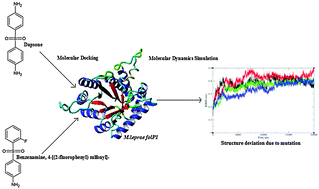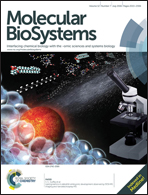Discovery of a potential lead compound for treating leprosy with dapsone resistance mutation in M. leprae folP1
Abstract
Dapsone resistance is a serious impediment to the implementation of the present leprosy control strategies. In the recent past, many studies have been undertaken to address the antibiotic activity and binding pattern of dapsone against both native and mutant (Pro55Leu) folP1. Yet, there is no well-developed structural basis for understanding drug action and there is dire need for new antibacterial therapies. In the present study, molecular simulation techniques were employed alongside experimental strategies to address and overcome the mechanism of dapsone resistance. In essence, we report the identification of small molecule compounds to effectively and specifically inhibit the growth of M. leprae through targeting dihydropteroate synthase, encoded by folP1 which is involved in folic acid synthesis. Initially, ADME and toxicity studies were employed to screen the lead compounds, using dapsone as standard drug. Subsequently, molecular docking was employed to understand the binding efficiency of dapsone and its lead compounds against folP1. Further, the activity of the screened lead molecule was studied by means of molecular dynamics simulation techniques. Furthermore, we synthesized 4-(2-fluorophenylsulfonyl)benzenamine, using (2-fluorophenyl)boronic acid and 4-aminobenzenesulfonyl chloride, and the compound structure was confirmed by 1H NMR and 13C NMR spectroscopic techniques. Most importantly, the antibacterial activity of the compound was also examined and compared against dapsone. Overall, the result from our analysis suggested that CID21480113 (4-(2-fluorophenylsulfonyl)benzenamine) could be developed into a promising lead compound and could be effective in treating dapsone resistant leprosy cases.


 Please wait while we load your content...
Please wait while we load your content...